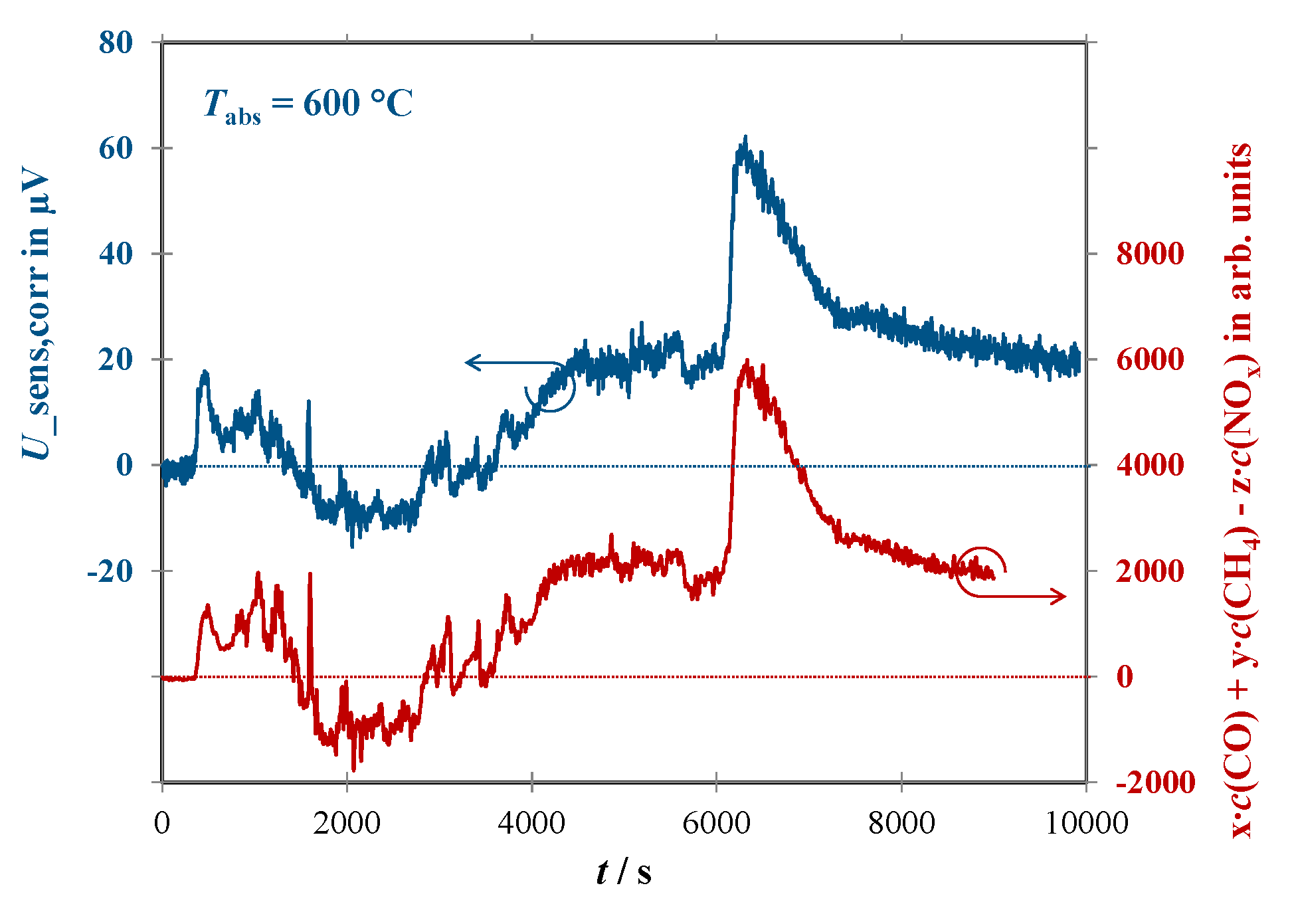Exhaust Gas Analysis of Firewood Combustion Processes: Application of a Robust Thermoelectric Gas Sensor †
Abstract
:1. Introduction
2. Experimental
3. Results
4. Conclusions and Outlook
Conflicts of Interest
References
- Ojha, B.; Illyaskutty, N.; Knoblauch, J.; Balachandran, M.R.; Kohler, H. High-temperature CO/HC gas sensors to optimize firewood combustion in low-power fireplaces. J. Sens. Sens. Syst. 2017, 6, 237–246. [Google Scholar] [CrossRef]
- Butschbach, P.; Hammer, F.; Kohler, H.; Potreck, A.; Trautmann, T. Extensive reduction of toxic gas emissions of firewood-fueled low power fireplaces by improved in situ gas sensorics and catalytic treatment of the exhaust gas. Sens. Actuators B Chem. 2009, 137, 32–41. [Google Scholar] [CrossRef]
- Andersson, M.; Pearce, R.; Spetz, A.L. New generation SiC based field effect transistor gas sensors. Sens. Actuators B Chem. 2013, 179, 95–106. [Google Scholar] [CrossRef]
- Wiegärtner, S.; Hagen, G.; Kita, J.; Reitmeier, W.; Hien, M.; Grass, P.; Moos, R. Thermoelectric hydrocarbon sensor in thick-film technology for on-board-diagnostics of a diesel oxidation catalyst. Sens. Actuators B Chem. 2015, 21, 234–240. [Google Scholar] [CrossRef]
- Kita, J.; Wiegärtner, S.; Moos, R.; Weigand, P.; Pliscott, A.; LaBranche, M.H.; Glicksman, H.D. Screen-printable type S thermocouple for thick-film technology. Procedia Eng. 2015, 120, 828–831. [Google Scholar] [CrossRef]
- Ritter, T.; Wiegärtner, S.; Hagen, G.; Moos, R. Simulation of a thermoelectric gas sensor to determine hydrocarbons in exhaust gases and to characterize catalyst materials. In Proceedings of the AMA Conferences 2017, Nürnberg, Germany, 30 May–1 June 2017. [Google Scholar] [CrossRef]
- Hagen, G.; Leupold, N.; Wiegärtner, S.; Moos, R. Sensor Tool for Fast Catalyst Material Characterization. Top. Catal. 2017, 60, 312–317. [Google Scholar] [CrossRef]


Publisher’s Note: MDPI stays neutral with regard to jurisdictional claims in published maps and institutional affiliations. |
© 2017 by the authors. Licensee MDPI, Basel, Switzerland. This article is an open access article distributed under the terms and conditions of the Creative Commons Attribution (CC BY) license (https://creativecommons.org/licenses/by/4.0/).
Share and Cite
Ojha, B.; Hagen, G.; Kohler, H.; Moos, R. Exhaust Gas Analysis of Firewood Combustion Processes: Application of a Robust Thermoelectric Gas Sensor. Proceedings 2017, 1, 457. https://doi.org/10.3390/proceedings1040457
Ojha B, Hagen G, Kohler H, Moos R. Exhaust Gas Analysis of Firewood Combustion Processes: Application of a Robust Thermoelectric Gas Sensor. Proceedings. 2017; 1(4):457. https://doi.org/10.3390/proceedings1040457
Chicago/Turabian StyleOjha, Binayak, Gunter Hagen, Heinz Kohler, and Ralf Moos. 2017. "Exhaust Gas Analysis of Firewood Combustion Processes: Application of a Robust Thermoelectric Gas Sensor" Proceedings 1, no. 4: 457. https://doi.org/10.3390/proceedings1040457
APA StyleOjha, B., Hagen, G., Kohler, H., & Moos, R. (2017). Exhaust Gas Analysis of Firewood Combustion Processes: Application of a Robust Thermoelectric Gas Sensor. Proceedings, 1(4), 457. https://doi.org/10.3390/proceedings1040457




